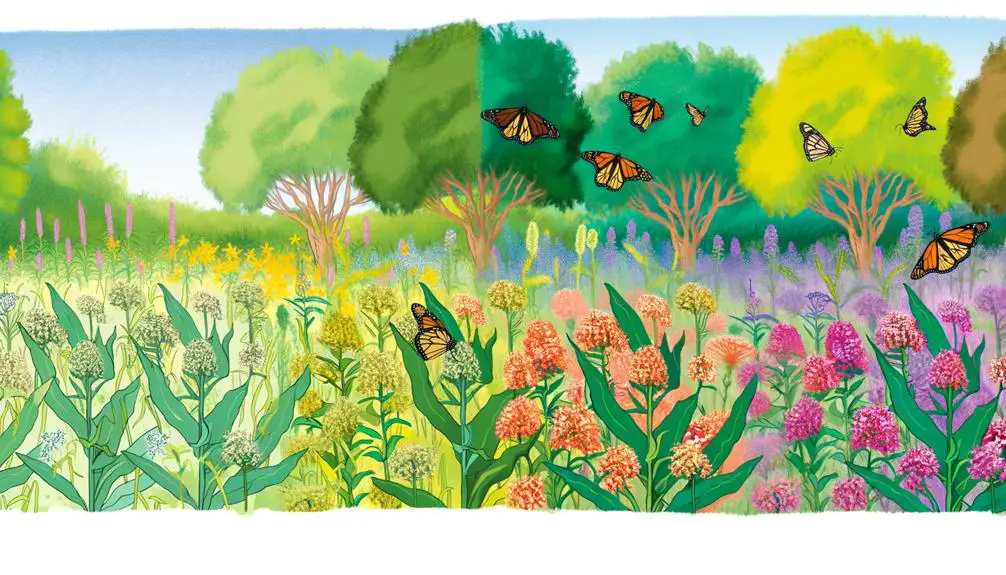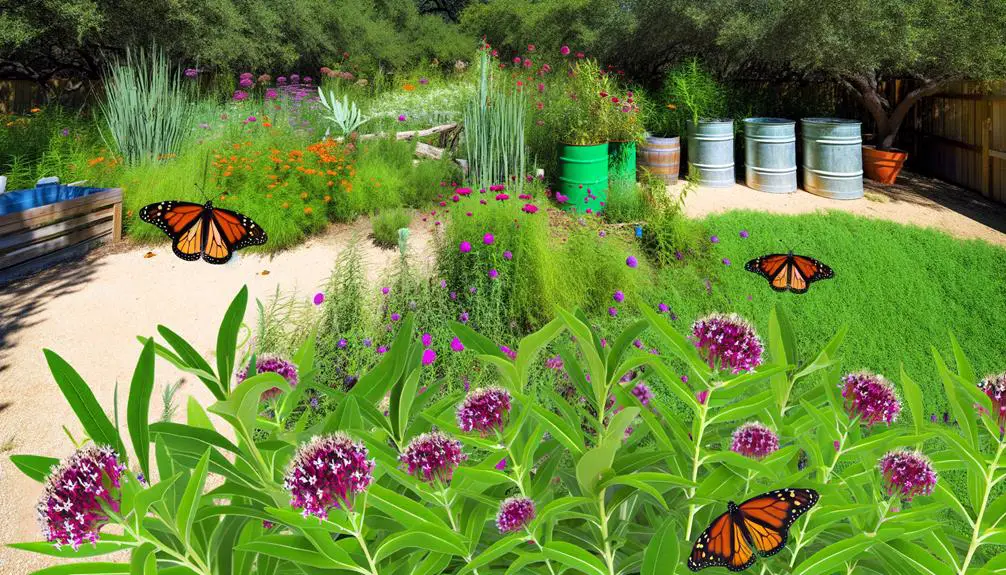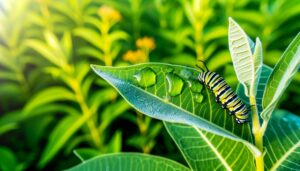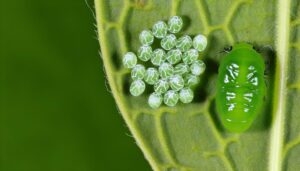10 Free Printables: Monarch Butterfly Life Cycle Diagrams
For supporting monarch butterflies in Texas, the integration of native milkweed species like Asclepias asperula and Asclepias viridis is crucial for caterpillar development due to their nutrient-rich, cardenolide-laden leaves that deter predators. Nectar-rich flowers such as Lantana camara cater to adult monarchs, providing essential energy during migration.
Emphasizing native plants maintains ecological balance and enhances habitat efficacy. Planting should align with migration periods, guaranteeing nectar availability.
Implementing sustainable gardening practices, including using shallow water dishes, dense foliage for shelter, and avoiding pesticides, guarantees an environment conducive to monarch survival. Those interested will uncover further ecological insights ahead.

Key Takeaways
- Native milkweed species like Asclepias asperula and Asclepias viridis are crucial for monarch larvae development in Texas.
- Nectar-rich flowers such as Lantana camara and Asclepias tuberosa provide essential energy for adult monarchs during migration.
- Plant milkweed in well-drained soil with full sunlight for optimal growth and caterpillar survival.
- Use native Texas plants to enhance ecological compatibility and support local monarch populations.
Milkweed Varieties

Numerous species of milkweed (Asclepias spp.) serve as critical host plants for monarch butterflies (Danaus plexippus) in Texas, providing essential resources for their larval development. Among the diverse varieties, Asclepias asperula (antelope horns) and Asclepias viridis (green milkweed) are particularly prevalent.
These species exhibit xerophytic adaptations, enabling survival in Texas' arid climates. The leaves of milkweed are rich in cardenolides, chemical compounds that confer toxicity to the larvae, deterring predators and offering a defensive mechanism.
Research indicates that maintaining a diverse array of milkweed species supports genetic diversity and resilience in monarch populations. In addition, planting native milkweed varieties guarantees ecological compatibility, optimizing larval survival rates and contributing to the conservation of this iconic migratory species.
Nectar-Rich Flowers
Nectar-rich flowers provide an essential energy source for adult monarch butterflies, facilitating their migration and reproductive activities. These flowers typically offer high sugar concentrations, which are vital for sustaining the butterflies' energy-intensive flight and reproductive processes.
Research indicates that adult monarchs prefer flowers with tubular shapes, bright colors, and accessible nectar. Species such as Lantana camara and Asclepias tuberosa exhibit these characteristics and have been documented to support monarchs effectively.
Additionally, the timing of nectar availability is significant; flowers must bloom during the peak migration periods in spring and fall. Ensuring a diverse array of nectar-rich plants can also mitigate risks associated with habitat fragmentation, thereby enhancing the overall resilience of monarch populations.
Native Texas Plants

Native Texas plants play an essential role in supporting Monarch butterflies, primarily through the provision of important milkweed varieties such as Asclepias asperula and Asclepias texana.
These plants not only offer vital nectar sources but also serve as host plants where Monarchs lay their eggs, facilitating larval development.
Research underscores the significance of these native species in maintaining the ecological balance and ensuring the survival of Monarch populations during their migratory journeys.
Milkweed Varieties
Several species of milkweed, scientifically known as Asclepias, are indigenous to Texas and play an essential role in the lifecycle of monarch butterflies.
Notable varieties include Asclepias asperula (Antelope Horns), Asclepias viridis (Green Milkweed), and Asclepias tuberosa (Butterfly Weed).
These species provide critical habitat and nourishment for monarch larvae, which feed exclusively on milkweed.
Antelope Horns, characterized by its whorled leaves and distinctively curved seed pods, thrives in arid conditions.
Green Milkweed, with its broad, elliptical leaves and greenish-white flowers, is adapted to prairies and open woodlands.
Butterfly Weed, distinguished by its vibrant orange flowers, prefers well-drained soils.
Conservation efforts emphasizing these native milkweeds are vital for sustaining monarch populations.
Nectar-Rich Flowers
In Texas, an array of indigenous flowering plants provides essential nectar sources for adult monarch butterflies, supporting their energy needs during migration and reproduction.
Key species include Asclepias tuberosa (Butterfly Weed) and Liatris mucronata (Blazing Star), both rich in nectar and well-adapted to the state's diverse climatic conditions.
Research indicates that nectar from native plants like Solidago spp. (Goldenrod) and Verbesina virginica (Frostweed) contains higher concentrations of sugars and amino acids, vital for monarch sustenance.
Additionally, Helianthus annuus (Common Sunflower) and Echinacea purpurea (Purple Coneflower) offer prolonged blooming periods, ensuring a consistent food supply.
These native species not only aid monarchs but also enhance biodiversity, supporting broader ecological health and freedom of natural systems.
Host Plant Benefits
Milkweed species, particularly Asclepias asperula (Antelope Horns) and Asclepias viridis (Green Milkweed), serve as critical host plants for monarch butterflies in Texas, providing the necessary habitat for oviposition and larval development.
These native plants are integral to the monarch's life cycle, offering essential nutrients and protection from predators. Research highlights various benefits of these host plants:
- Nutrient-Rich Leaves: Essential for larval growth and development.
- Chemical Defense: Milkweed toxins deter predation, enhancing larval survival rates.
- Habitat Provision: Supports biodiversity and ecosystem stability.
- Climate Adaptation: Thrives in Texas's varied climatic conditions.
Utilizing native milkweed guarantees monarch conservation efforts are both effective and sustainable.
Caterpillar Host Plants
Monarch butterfly caterpillars exhibit a strong preference for specific milkweed varieties, such as Asclepias asperula and Asclepias viridis, which are native to Texas and provide essential nutrients for larval development.
Planting strategies should prioritize soil conditions, sunlight exposure, and spacing to optimize growth and caterpillar sustenance.
Research indicates that native milkweed species are more beneficial than non-native alternatives, supporting higher survival rates and healthier monarch populations.
Milkweed Varieties Preferred
Several species of Asclepias, commonly known as milkweeds, serve as critical larval host plants for Danaus plexippus, the monarch butterfly, due to their unique phytochemical properties. These plants contain cardenolides, toxic compounds that monarch caterpillars sequester for defense against predators.
In Texas, the following milkweed species are particularly beneficial:
- Asclepias asperula (Antelope Horns): Thrives in dry, sandy soils and provides early-season foliage.
- Asclepias viridis (Green Milkweed): Common in prairies and meadows, offering substantial leaf mass.
- Asclepias tuberosa (Butterfly Weed): Known for its bright orange flowers, attracting both butterflies and caterpillars.
- Asclepias incarnata (Swamp Milkweed): Prefers moist environments, supporting caterpillar growth during late summer.
Each species supports monarch populations through specific ecological niches.
Planting Tips for Success
To guarantee ideal growth and support for monarch caterpillars, it is essential to take into account soil type, sunlight exposure, and local climate conditions when planting host plants.
Milkweed species, the primary caterpillar host, thrive best in well-drained soil with moderate to high organic matter. Full sunlight, approximately six hours daily, optimizes growth and enhances the nutritional value of the foliage.
Given Texas's diverse climate zones, selecting species adapted to specific regional conditions is imperative. For instance, Asclepias asperula, suited to arid areas, contrasts with Asclepias incarnata, which prefers moist environments.
Contiguous planting in clusters rather than isolated spots fosters a microhabitat conducive to caterpillar survival and predator deterrence. Regular monitoring and organic pest control methods are recommended for maintaining plant health.
Native Vs. Non-Native
Choosing between native and non-native caterpillar host plants involves evaluating their ecological compatibility, potential impact on local biodiversity, and the specific needs of monarch butterflies at various life stages.
Native plants, such as Asclepias tuberosa (Butterfly Weed), have co-evolved with monarchs, guaranteeing ideal nutritional profiles and habitat support. Conversely, non-native plants may lack these synergies, potentially disrupting local ecosystems.
- Ecological Compatibility: Native species generally integrate better with local flora and fauna.
- Nutritional Adequacy: Native milkweeds provide essential nutrients for monarch larvae.
- Biodiversity Impact: Non-native plants can outcompete local species, reducing biodiversity.
- Pesticide Exposure: Non-natives are often treated with pesticides harmful to caterpillars.
This meticulous selection guarantees monarch conservation aligns with ecological balance and sustainability.
Seasonal Planting Tips

Ideal timing for planting milkweed and nectar plants plays a crucial role in creating a habitat that supports the various life stages of monarch butterflies in Texas.
Research indicates that milkweed, the sole larval host plant for monarch caterpillars, should be sown in early spring, around March to April, coinciding with the northward migration of monarchs.
Nectar plants, necessary for adult monarchs, should also be planted during this period but can extend into late spring to guarantee a continuous bloom cycle.
Selecting region-specific species like Asclepias asperula (Antelope Horns) and Asclepias viridis (Green Milkweed) is critical for ideal growth and support.
Implementing these seasonal planting strategies maximizes habitat efficacy, fostering a thriving environment for monarch populations.
Water and Shelter
Adequate water sources and appropriate shelter are essential for establishing a sustainable habitat that supports the survival and reproductive success of monarch butterflies in Texas. Monarchs require water not only for hydration but also for thermoregulation and nectar dilution. It is important to provide shallow water sources, such as bird baths with stones for perching.
Additionally, shelter from harsh weather and predators can be facilitated through the strategic planting of native shrubs and tall grasses. Key elements to take into account include:
- Shallow water dishes with perching stones.
- Dense foliage for protection against predators.
- Native shrubs for natural shelter and food.
- Tall grasses for roosting sites.
These elements collectively enhance habitat resilience and monarch viability.
Sustainable Gardening Practices

Implementing sustainable gardening practices is essential for creating an ecologically balanced habitat that supports the lifecycle of monarch butterflies while minimizing environmental impact. Utilizing native plants reduces water usage and fosters local biodiversity. Avoiding chemical pesticides preserves beneficial insects and prevents soil and water contamination. Composting organic waste enhances soil fertility and structure, promoting robust plant health. Encouraging natural predators helps manage pest populations organically, reducing reliance on synthetic inputs.
| Practice | Benefit |
|---|---|
| Native Plants | Reduced water usage, biodiversity |
| No Chemical Pesticides | Protects beneficial insects |
| Composting | Enhances soil fertility |
These strategies, grounded in ecological principles, offer a sustainable approach to gardening, ensuring monarch butterflies flourish in a resilient, thriving ecosystem.
Conclusion
Coinciding with the crucial role of Texas ecosystems, the cultivation of milkweed varieties, nectar-rich flowers, and native plants fosters the survival of monarch butterflies.
The inclusion of caterpillar host plants and adherence to seasonal planting tips further enhance habitat suitability.
Providing water and shelter, alongside sustainable gardening practices, guarantees a thriving environment.
Consequently, the strategic implementation of these elements not only supports monarch populations but also strengthens the ecological fabric of Texas.






